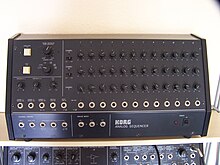Analog sequencer

An analog sequencer , even analog sequencer , a music sequencer from analog electronics , was invented in the first half of the 20th century. It is used to control electronic musical instruments such as synthesizers . Computer music developed from the beginnings of music sequencing , later this expanded to the areas of music composition and sound generation .
history
Raymond Scott designed and built some of the first electro-mechanical music sequencers in the 1940s. The RCA Mark II Sound Synthesizer from 1957 was initially controlled indirectly via a perforated belt system, which was similar to the piano rolls, a kind of mechanical sequencer. In earlier electronic music, artists used sound-on-film technology to create sound waves and control sequences of notes.
In the simplest case, an analog sequencer consists of a series of potentiometers and a "clock" (pulse generator) connected to a sequencer that runs through these potentiometers one by one and then returns to the beginning. The sequencer output is fed to a synthesizer (as control voltage and gate pulse). By “tuning” the potentiometers, a short repetitive rhythmic motif or riff can be set.
The most commonly used analog sequencer was the Moog 960 , a module of the Moog modular synthesizer . It consisted of three parallel banks of eight potentiometers: the three banks could either control three different voltage controlled oscillators (VCOs) to allow three note chords in the sequence, or (for example) one row could control the pitch while the second was The third row controls the filter cutoff or VCA volume, and a third controls the filter cutoff for a generator that produces white noise , creating an extremely primitive electronic drum track.
In each of the eight steps, a switch offered three options: play this step, skip this step, or go back to the beginning. In order to avoid the monotony of endlessly repeated sequences, pioneering electronic musicians such as Christopher Franke from Tangerine Dream and Michael Hoenig manipulated these switches in real time during the performance and added notes and beats to a sequence or left them out. In addition, the “Pitch” row can be linked to two or more oscillators that are tuned to intervals, and the oscillators can be faded in and out individually.
Good examples of all of these techniques can be heard on the Phaedra , Rubycon , Ricochet , and Encore albums by Tangerine Dream and on Departure from the Northern Wasteland by Michael Hoenig.
By synchronizing two sequencers and using them individually, swirling polyrhythmic phasing patterns (as introduced in Minimal Music by Steve Reich ) can be set up. The title track from Michael Hoenig's album is an excellent example.
An additional module (Moog 962) enabled the three lines to be “chained” to form a longer sequence with 24 steps. In addition, a switch on the 960 itself allows the third (lower) row to be used for note lengths.
The output voltage of the sequencer can be added to the output voltage of a keyboard controller in order to use the latter to transpose the sequence on the fly . Klaus Schulze liked this technique, which lays the musical basis for tracks like “ Bayreuth Return ” by Timewind , “ Floating ” by Moondawn and the rhythmic pieces from Schulze's “analog” years. Vangelis and Jean-Michel Jarre also used this technique.
Aside from a temperature controlled environment after warming up, pitch stability can be a problem. At the famous opening of Phaedra, the sequencer was out of tune and you can clearly hear Chris Franke retune the sequence by ear in real time.
In addition to the 1027 module, which is a conventional 3x10 step sequencer, the ARP 2500 was often equipped with the 1050 mix sequencer module. In contrast to modern sequencers, which only generated voltages, the 1050 could also sequence audio signals. This allowed each step of the sequence to come from a completely different sound source. The 8 positions could run sequentially or be split into two independent four-step sequencers. It's easy to identify by the vertical column of 8 square white buttons that light up to indicate the active steps.
Analog sequencers have in some respects been replaced by digital devices and software implementations. However, there is ongoing interest from modular analog synthesis users who appreciate the real-time control that an analog sequencer provides, such as the ' Oberkorn ' machine from Analog Solutions , among others .
Analog sequencer gallery
One of the first available analog sequencers (below, 3 × 8-step and 3 × 16-step) on Buchla 100 (1964/1966)
Former Moog sequencer (linkls, gfs added from 1968) on the first commercially sold Moog Modular prototype (around 1964)
ARP 1027 Clocked Sequential Control Module (3rd & 4th from right) and 1050 Mix sequencer module to the right on ARP 2500 (1970)
EML Sequencer 400 (top × 2, 6 × 16 step) on EML ElectroComp modular synthesizer (1970)
Roland "Block 3" analog sequencer (top, 3 × 12 step) on Roland System 700 (1976)
Roland System 100M Model 182 sequencer
Doepfer MAQ16-3 MIDI analog sequencer
Trivia
- The Swedish band Wintergatan introduced a machine made of wood called the “ Marble Machine ” in 2017 , which can be viewed as a mechanical sequencer.
See also
Web links
supporting documents
- ↑ Thom Holmes: Electronic and experimental music: technology, music, and culture . Taylor & Francis, 2008, ISBN 978-0-415-95781-6 , p. 222: “Moog admired Buchla's work, recently stating that Buchla designed a system not only for 'making new sounds but [for] making textures out of these sounds by specifying when these sounds could change and how regular those change would be. "
- ↑ close encounters of the ARP kind - ARP 2500 Modular Analogue Synthesis System . In: Sound on Sound . No. Aug. 1996, September.
- ↑ Nicolay Ketterer: The Marble Machine by the Swedish band Wintergatan. Keyboards - Analog Sequencer for Purists, March 23, 2020, accessed August 7, 2020 .













